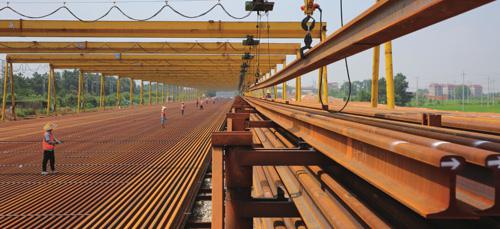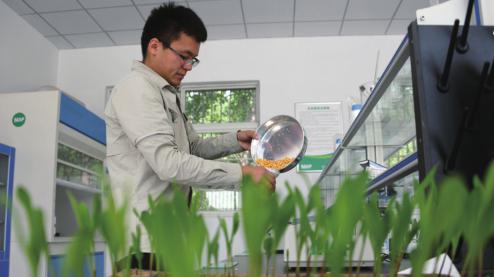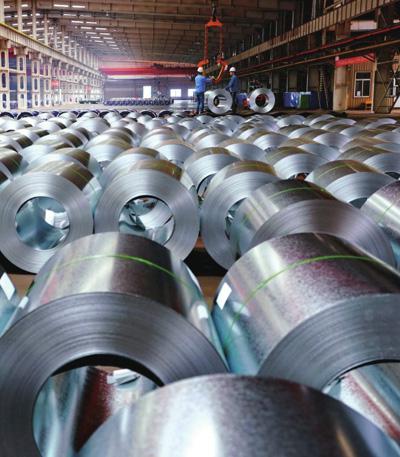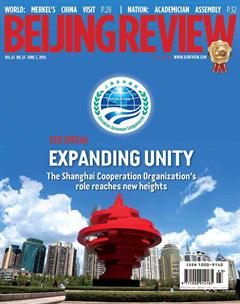Sharing the Joy

Children perform a dragon dance at a ceremony marking International Childrens Day, which falls on June 1, in a kindergarten in Yuanqu County, north Chinas Shanxi Province, on May 29.
Space Cooperation
China announced that all UN member states are welcome to jointly utilize its future China Space Station(CSS) on May 28.
“The CSS belongs not only to China, but also to the world,” said Shi Zhongjun, Chinas Ambassador to the UN and Other International Organizations in Vienna.
“All countries, regardless of their size and level of development, can participate in the collaboration on an equal footing,” he said.
Interested public and private organizations, including institutes, academies, universities and private enterprises with scientifi c orientations, can identify their appropriate models of cooperation on board the CSS, whether its the growth of a space plant or the accommodation of an astronaut, said the ambassador.
The CSS, which is expected to be launched by 2019 and be completed and operating by 2022, will be the worlds fi rst space station that is built by a developing country.
Consisting of one core module and two experimental modules, the CSS will have the capacity to accommodate up to three astronauts at a time and a maximum of six in rotation.
Operating in low Earth orbit about 400 km above the Earths surface, the CSS will be used in a wide range of research fi elds, including space medicine, life science, biotechnology, microgravity science, Earth science and space technology.
Better Air Quality
Air quality in the Beijing-TianjinHebei region improved in the fi rst four months of this year compared with the same period last year, according to the Ministry of Ecology and Environment.
Good air days accounted for an average of 59.1 percent of total days in the 13 cities in the region, up 2.2 percentage points year on year, ministry data showed.
The density of PM2.5 (airborne particles smaller than 2.5 microns in diameter), a key indicator of air pollution, dropped 18.8 percent year on year during the same period, while the density of PM10, another major pollutant, fell 12.9 percent.
Beijing saw the ratio of good air quality days increase by 3.9 percentage points to 64.7 percent in the period, with PM2.5 and PM10 density down 22.4 percent and 9.9 percent, respectively.
Nationwide, 338 cities had an average of 76.7 percent days with good air quality days, up 0.9 percentage points year on year.
However, in April, air quality got worse in the Beijing-Tianjin-Hebei region. The average amount of days with good air quality was 58 percent, down 13.7 percentage points from April last year, with lower PM2.5 density but higher PM 10 density. A ministry statement attributed the change from the previous month to frequent sandy and dusty days, increased industrial and construction activities, and static weather patterns, which make it diffi cult for airborne pollutants to disperse.
WHO Certification
The World Health Organization(WHO) granted its highest certifi cation level to a Chinese international emergency medical team (EMT) on May 25, making China the country with the most WHO-certifi ed EMTs.
During the 71st World Health Assembly in Geneva, WHO Director General Tedros Adhanom Ghebreyesus hosted a certifi cation ceremony for the China International Emergency Medical Team (Sichuan) at the UN offi ce.
The team is a partnership of several hospitals from Chinas southwest Sichuan Province with 166 professionals, including 41 doctors and 65 nurses. Its the fi rst Chinese medical team to be verifi ed as Type 3, the highest level in the WHO EMTs Initiative, capable of treating 200 outpatients and performing 15 major surgical procedures and 30 minor surgical procedures per day.
At the ceremony, Adhanom Ghebreyesus said he plans to expand WHO EMTs to include about 50,000 medical professionals in the next few years and expects even more support from China.
The team from Sichuan is the third Chinese EMT to be certifi ed by the WHO. In 2016 and 2017, respectively, two EMTs from Chinas Shanghai and Guangdong Province were granted the certifi cation, making China the only country that has contributed three teams to the initiative which consists of 15 teams to date.
The WHO EMTs project was launched in July 2015 to qualityassure and peer-review global teams in light of past shortcomings where medical personnel self-responded without necessarily having the right skill-set, training, supplies or equipment. It aims to help countries affected by disasters, outbreaks and emergencies to identify teams that are appropriately trained and equipped when they seek international medical assistance.
Homegrown PNT System
A high-precision national comprehensive positioning, navigation and timing (PNT) system based on the BeiDou Navigation Satellite System will be fi nished by 2035, offi cial sources said.
With the completion of the system, China will improve its capability in space and time information services, said Ran Chengqi, head of the Offi ce for the Management of the BeiDou Navigation Satellite System. He made his remarks during the Ninth China Satellite Navigation Conference held in Harbin, capital of northeast Chinas Heilongjiang Province, on May 23-25.
Named after the Chinese term for the Big Dipper constellation, the BeiDou project was formally initiated in 1994. It began to serve China in 2000 and the Asia-Pacifi c region at the end of 2012.
By around 2020, when the BeiDou system is due to go global, it will have more than 30 satellites.
The BeiDou system has been widely used in China for public security, transportation, fi shing, power supplies, forestry and disaster relief.
For example, 33,500 taxis and 21,000 buses in Beijing, and 40,000 fi shing boats off the countrys coast are equipped with terminals from the BeiDou system.
Chinas satellite navigation industry was worth 255 billion yuan($39.9 billion) in 2017.
Rural Teachers
China will recruit another 10,000 college graduates to teach in primary and middle schools in rural areas this year, an offi cial with the Ministry of Education (MOE) said on May 25.
The recruitment drive aims to address the shortage of teachers in deep poverty areas, in Tibet Autonomous Region, as well as Sichuan and Yunnan provinces, said Zheng Fuzhi, Assistant Minister of Education.
“Generally, there are not enough teachers in rural areas and the proportion of different kinds of teachers is not appropriate,” Zheng said.
MOE helped recruit 24,000 college graduates to teach in minority areas and in 2017, trained 500,000 teachers in such areas.
The ministry will further increase investment in education and launch more favorable policies to benefi t poverty-stricken areas along with other governmental departments.
It will also make efforts to ensure the average income of teachers in primary and middle schools does not fall below that of civil servants in the same areas.
Mobile Services
Students read books at a mobile library on train No. 6063 on May 27. The train, which links 38 stations along the route from Baoji in northwest Chinas Shaanxi Province to Guangyuan in southwest Chinas Sichuan Province, serves thousands of students in mountainous areas who need to commute from school to home every week. To improve services, special carriages installed with bigger desks and a mobile library were put into use at the end of 2017.

Help for Drug Addicts
China will create a national unifi ed system for drug detoxifi cation and rehabilitation as part of efforts to help drug addicts get clean, Vice Minister of Justice Liu Zhiqiang said on May 29.
The ministry recently issued a guideline requiring authorities to focus on professional rehabilitation centers, scientifi c drug detoxifi cation and supportive measures.
The ministry will increase efforts to develop technologies and create technical norms and a standardized system for drug detoxifi cation, Liu said.
He added that the ministry will continue to support and guide community-based drug detoxifi cation and rehabilitation programs.
China is home to 361 drug detoxifi cation centers that are able to accommodate 320,000 drug addicts.
Skilled Stunts
A contender bungee jumps from the Zhangjiajie Grand Canyons glass-bottom bridge during a challenge at the Zhangjiajie scenic spot, central Chinas Hunan Province, on May 26.
The event drew participants from Russia, Australia, the UK and other countries.
Consensus Broken
A White House statement on May 29 about tariffs on Chinese exports clearly contradicts the consensus reached recently by the two countries in Washington, D.C., a Ministry of Commerce (MOFCOM) spokesperson said.
The White House statement renewed the U.S. threat to place 25-percent tariffs on $50 billion worth of Chinese goods, revealing plans to target cutting-edge technologies, the Associated Press reported.
MOFCOM said that while the White Houses tactical statement was unexpected it does not come as a surprise.
“Whatever measures the United States takes, China has the confi -dence, capability and experience to defend the interests of the Chinese people and the core interests of the country,” MOFCOM said on its website.
China has urged the United States to meet it halfway, in line with the recent bilateral joint statement, the spokesperson said.
CDRs Debut
Chinese tech companies listed overseas will soon issue Chinese Depository Receipts (CDR) on the Shanghai and Shenzhen stock exchanges, Fang Xinghai, Vice Chairman of China Securities Regulatory Commission (CSRC), said on May 29.
Fang said that the move would effectively combine Chinese tech companies with Chinese capital as“red-chip” enterprises, which operate in China but are registered and listed overseas, return to the A-share market by issuing CDRs.
CDRs, which are similar to U.S. depositary receipts, are certifi cates allowing investors to hold shares listed across borders.
The CSRC released draft rules in May under which the CDR pilot program applies to fi rms listed overseas—each with a market capitalization of no less than 200 billion yuan ($31.7 billion)?that operate on the Chinese mainland.
Zhang Dongke, Deputy General Manager of the Shanghai Stock Exchange, said on May 28 that the board had fi nished all of the preparatory work necessary for the pilot CDR program.
Dong Dengxin, a fi nance professor at the Wuhan University of Science and Technology, said that the introduction of the CDR system shows that Chinese regulators have become more willing to embrace innovation and bring vitality to the nations capital market.
Fang also said the CSRC is accelerating the introduction of the fi rst product for the trading link between Shanghai and London, taking the fi rst step in connecting the worlds largest emerging market to mature markets elsewhere.
The Peoples Bank of China Governor Yi Gang announced in April that China aims to launch the Shanghai-London stock connect within the year, allowing traders in both nations to buy on each others markets across time zones.
“Chinas capital market will continue to open to the world in breadth and depth,” said Fang.
Right on Track
Workers unload steel rails along the Nanchang-Ganzhou high-speed railway on May 30.
The preparations constitute the track laying of the railway line, which runs 415 km and makes up an important part of the Beijing-Kowloon High-Speed Railway.
Tax Reduction
China is to expand a tax cut program for technologically advanced service fi rms nationwide.
The rate of corporate income tax will be cut to 15 percent for businesses in the service trade sector which qualify as technologically advanced, according to a statement released by the Ministry of Finance.
The tax cut has been in place in 15 regions including Tianjin, Shanghai and Shenzhen since 2016 on a trial basis.
Seventeen other regions, including Beijing, will join the program between July 1, 2018 and June 30, 2020, to further promote innovative service trade.
Chinas service trade volume has ample room for growth compared with developed countries. Trade in services totaled 4.7 trillion yuan($730 billion) in 2017, up 6.8 percent year on year.
New Tech Hub
Guizhou Province, one of Chinas least developed regions, has become a hub for Chinas Big Data industry, attracting Tencent and other global tech giants as the countrys digital economy continues to prosper.
During the China International Big Data Industry Expo 2018 held in the provincial capital of Guiyang from May 26 to 29, 199 projects were signed, attracting total investment of 35.28 billion yuan ($5.5 billion), according to the organizing committee.
As Chinas f rist Big Data pilot zone, the mountainous province is a top choice for Big Data facilities due to its moderate climate, suff ciient power supply and good network infrastructure. It has already attracted heavyweights such as Apple, Qualcomm, Huawei, Tencent, Alibaba and Foxconn to establish cloud computing and Big Data cen-ters as well as regional headquarters.
Tencents Qixing data center in Guizhou started trial operations on May 28. With around 50,000 servers stored inside karst caves concealed in the mountains in Guian New District, the center is a green, effi cient backup for disaster recovery.
E-commerce giant Alibaba announced on May 28 that Guiyang would become the technical support center and Internet content provider fi ling center for Alibaba Cloud.
So far, the number of big data enterprises in Guizhou has grown from less than 1,000 in 2013 to 8,548, with the value of the industry exceeding 110 billion yuan ($17.19 billion).
Guizhous digital economy expanded by 37.2 percent in 2017, the fastest in the country, offi cial data showed. The added value of the digital economy will account for 30 percent of Guizhous GDP by 2020, according to a provincial government plan.
Advanced Agriculture
An expert tests the water ratio of corn at a modern agricultural service center in Gaoqing County, east Chinas Shandong Province, on May 29.
The center was jointly built by Gaoqing and the Sinochem Group. So far, it has served more than 200 producers, effectively improving local agricultural plantation and operation.
Import Demand
Demand remains strong for imported products in China, especially in food and beverages, cosmetics, automobiles, watches and acces- sories, maternal care products and jewelry, driven by the countrys ongoing consumption upgrade.
According to a report released by the Ministry of Commerce, imported goods are an important part of domestic consumption, especially from a retail perspective, with a fourth of the surveyed 1,018 retailers stating that nearly 50 percent of their revenue came from imported products. About 39.2 percent of them indicated that brands are the decisive factor in their choice of what to import, followed by other aspects like safety, price, design and materials.
Over 85.5 percent of the surveyed companies indicated that they would maintain the current volume of imports next year, while 7.2 percent said they would increase shipments, especially in food and beverages, sportswear, maternal care products and cosmetics.
Overseas CSR
Chinas fi rst research report on centrally administered state-owned enterprises efforts to carry out social responsibility overseas has been published.
The report pointed out that about 61.5 percent of enterprises lacked trained professionals in the fi eld, and 32.3 percent surveyed said that they needed a better understanding of local cultures and legal systems in order to better carry out their corporate social responsibility(CSR) efforts.
“Actually, Chinas SOEs have been actively contributing to local economic development and environmental protection in the past few years, but their efforts have been little known to the public,”said Zhong Hongwu, Director of the Research Center for Corporate Social Responsibility at the Chinese Academy of Social Sciences.
“Cross-cultural communication matters a lot in the overseas CSR efforts of central SOEs, especially in community service,” Zhong added. “It also matters to enterprisesdaily operations as they employ workers from different cultural backgrounds.”
The report suggests closer cooperation with local charitable organizations to facilitate communication for more effi cient CSR operations. It also calls for an evaluation system of the overseas CSR performance from the StateOwned Assets Supervision and Administration Commission of the State Council, the countrys SOE regulator.
Steeling the Show
Steel plates are transported at a galvanized steel sheet manufacturer in the Haigang Development Zone, Tangshan, Hebei Province, on May 29.
In recent years, the Haigang Development Zone has expedited a shift in growth drivers by promoting emerging industries such as equipment manufacturing, new energy and high-quality steel industries.

